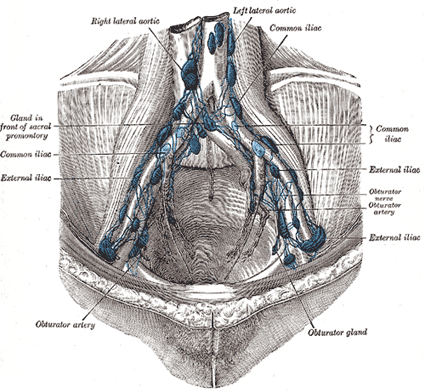 |
| FIG. 611– The parietal lymph glands of the pelvis. (Cunéo and Marcille.) |
|
| |
| The Lymph Glands of the Abdomen and Pelvis—The lymph glands of the abdomen and pelvis may be divided, from their situations, into (a) parietal, lying behind the peritoneum and in close association with the larger bloodvessels; and (b) visceral, which are found in relation to the visceral arteries. |
| The parietal glands (Figs. 611, 612) include the following groups: |
| External Iliac. | |
Iliac Circumflex. | |
Lumbar |
Lateral Aortic. |
| Common Iliac. | |
Hypogastric. | |
Preaortic. |
| Epigastric. | |
Sacral. | |
Retroaortic. | |
| The External Iliac Glands, from eight to ten in number, lie along the external iliac vessels. They are arranged in three groups, one on the lateral, another on the medial, and a third on the anterior aspect of the vessels; the third group is, however, sometimes absent. Their principal afferents are derived from the inguinal and subinguinal glands, the deep lymphatics of the abdominal wall below the umbilicus and of the adductor region of the thigh, and the lymphatics from the glans penis vel clitoridis, the membranous urethra, the prostate, the fundus of the bladder, the cervix uteri, and upper part of the vagina. |
| The Common Iliac Glands, four to six in number, are grouped behind and on the sides of the common iliac artery, one or two being placed below the bifurcation of the aorta, in front of the fifth lumbar vertebra. They drain chiefly the hypogastric and external iliac glands, and their efferents pass to the lateral aortic glands. |
| The Epigastric Glands (lymphoglandulæ epigastricæ), three or four in number, are placed alongside the lower portion of the inferior epigastric vessels. |
| |
| The Iliac Circumflex Glands, two to four in number, are situated along the course of the deep iliac circumflex vessels; they are sometimes absent. |
| The Hypogastric Glands (lymphoglandulæ hypogastricæ; internal iliac gland) (Fig. 612) surround the hypogastric vessels, and receive the lymphatics corresponding to the distribution of the branches of the hypogastric artery, i. e., they receive lymphatics from all the pelvic viscera, from the deeper parts of the perineum, including the membranous and cavernous portions of the urethra, and from the buttock and back of the thigh. An obturator gland is sometimes seen in the upper part of the obturator foramen. |
| The Sacral Glands are placed in the concavity of the sacrum, in relation to the middle and lateral sacral arteries; they receive lymphatics from the rectum and posterior wall of the pelvis. |
| The efferents of the hypogastric group end in the common iliac glands. |
| The Lumbar Glands (lymphoglandulæ lumbales) are very numerous, and consist of right and left lateral aortic, preaortic, and retroaortic groups. |
 |
| FIG. 612– Iliopelvic glands (lateral view). (Cunéo and Marcille.) |
| |
| The right lateral aortic glands are situated partly in front of the inferior vena cava, near the termination of the renal vein, and partly behind it on the origin of the Psoas major, and on the right crus of the diaphragm. The left lateral aortic glands form a chain on the left side of the abdominal aorta in front of the origin of the Psoas major and left crus of the diaphragm. The glands on either side receive (a) the efferents of the common iliac glands, (b) the lymphatics from the testis in the male and from the ovary, uterine tube, and body of the uterus in the female; (c) the lymphatics from the kidney and suprarenal gland; and (d) the lymphatics draining the lateral abdominal muscles and accompanying the lumbar veins. Most of the efferent vessels of the lateral aortic glands converge to form the right and left lumbar trunks which join the cisterna chyli, but some enter the pre- and retroaortic glands, and others pierce the crura of the diaphragm to join the lower end of the thoracic duct. The preaortic glands lie in front of the aorta, and may be divided into celiac, superior mesenteric, and inferior mesenteric groups, arranged around the origins of the corresponding arteries. They receive a few vessels from the lateral aortic glands, but their principal afferents are derived from the viscera supplied by the three arteries with which they are associated. Some of their efferents pass to the retroaortic glands, but the majority unite to form the intestinal trunk, which enters the cisterna chyli. The retroaortic glands are placed below the cisterna chyli, on the bodies of the third and fourth lumbar vertebræ. They receive lymphatic trunks from the lateral and preaortic glands, while their efferents end in the cisterna chyli. |
| |
| the Lymphatic Vessels of the Abdomen and Pelvis |
| The lymphatic vessels of the walls of the abdomen and pelvis may be divided into two sets, superficial and deep. |
| The superficial vessels follow the course of the superficial bloodvessels and converge to the superficial inguinal glands; those derived from the integument of the front of the abdomen below the umbilicus follow the course of the superficial epigastric vessels, and those from the sides of the lumbar part of the abdominal wall pass along the crest of the ilium, with the superficial iliac circumflex vessels. The superficial lymphatic vessels of the gluteal region turn horizontally around the buttock, and join the superficial inguinal and subinguinal glands. |
| The deep vessels run alongside the principal bloodvessels. Those of the parietes of the pelvis, which accompany the superior and inferior gluteal, and obturator vessels, follow the course of the hypogastric artery, and ultimately join the lateral aortic glands. |
| |
| Lymphatic Vessels of the Perineum and External Genitals.—The lymphatic vessels of the perineum, of the integument of the penis, and of the scrotum (or vulva), follow the course of the external pudendal vessels, and end in the superficial inguinal and subinguinal glands. Those of the glans penis vel clitoridis terminate partly in the deep subinguinal glands and partly in the external iliac glands. |
| The visceral glands are associated with the branches of the celiac, superior and inferior mesenteric arteries. Those related to the branches of the celiac artery form three sets, gastric, hepatic, and pancreaticolienal. |
| The Gastric Glands (Figs. 613, 614) consist of two sets, superior and inferior. |
| The Superior Gastric Glands (lymphoglandulæ gastricæ superiores) accompany the left gastric artery and are divisible into three groups, viz.: (a) upper, on the stem of the artery; (b) lower, accompanying the descending branches of the artery along the cardiac half of the lesser curvature of the stomach, between the two layers of the lesser omentum; and (c) paracardial outlying members of the gastric glands, disposed in a manner comparable to a chain of beads around the neck of the stomach (Jamieson and Dobson (*110). They receive their afferents from the stomach; their efferents pass to the celiac group of preaortic glands. |
| The Inferior Gastric Glands (lymphoglandulæ gastricæ inferiores; right gastroepiploic gland), four to seven in number, lie between the two layers of the greater omentum along the pyloric half of the greater curvature of the stomach. |
| The Hepatic Glands (lymphoglandulæ hepaticæ) (Fig. 613), consist of the following groups: (a) hepatic, on the stem of the hepatic artery, and extending upward along the common bile duct, between the two layers of the lesser omentum, as far as the porta hepatis; the cystic gland, a member of this group, is placed near the neck of the gall-bladder; (b) subpyloric, four or five in number, in close relation to the bifurcation of the gastroduodenal artery, in the angle between the superior and descending parts of the duodenum; an outlying member of this group is sometimes found above the duodenum on the right gastric (pyloric) artery. The glands of the hepatic chain receive afferents from the stomach, duodenum, liver, gall-bladder, and pancreas; their efferents join the celiac group of preaortic glands. |
| The Pancreaticolienal Glands (lymphoglandulæ pancreaticolienales; splenic glands) (Fig. 614) accompany the lienal (splenic) artery, and are situated in relation to the posterior surface and upper border of the pancreas; one or two members of this group are found in the gastrolienal ligament (Jamieson and Dobson, op. cit.). Their afferents are derived from the stomach, spleen, and pancreas, their efferents join the celiac group of preaortic glands. |
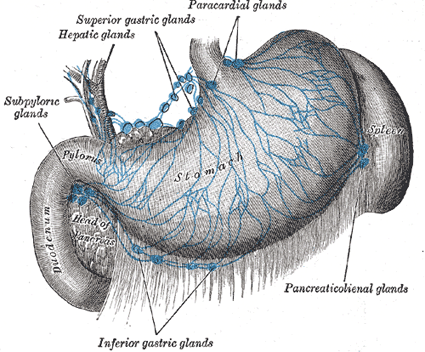 |
| FIG. 613– Lymphatics of stomach, etc. (Jamieson and Dobson.) |
| |
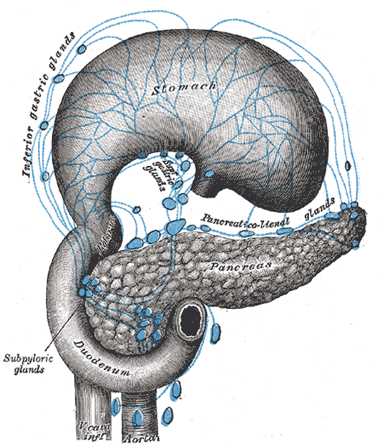 |
| FIG. 614– Lymphatics of stomach, etc. The stomach has been turned upward. (Jamieson and Dobson.) |
| |
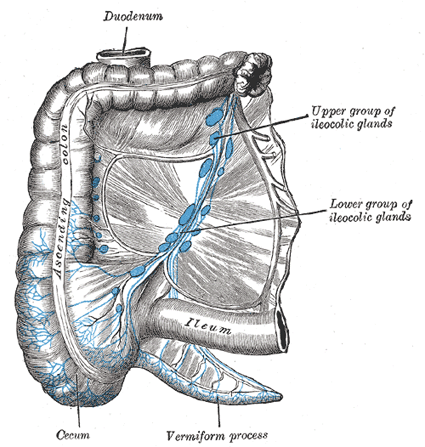 |
| FIG. 615– The lymphatics of cecum and vermiform process from the front. (Jamieson and Dobson.) |
| |
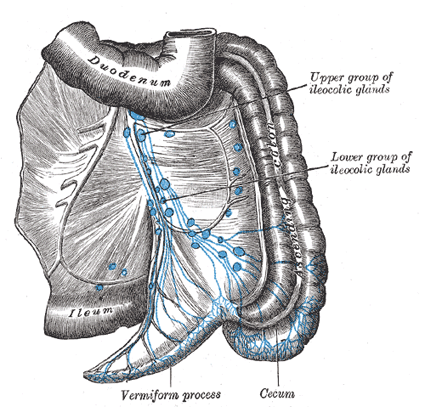 |
| FIG. 616– The lymphatics of cecum and vermiform process from behind. (Jamieson and Dobson.) |
| |
| The superior mesenteric glands may be divided into three principal groups: mesenteric, ileocolic, and mesocolic. |
| The Mesenteric Glands (lymphoglandulæ mesentericæ) lie between the layers of the mesentery. They vary from one hundred to one hundred and fifty in number, and may be grouped into three sets, viz.: one lying close to the wall of the small intestine, among the terminal twigs of the superior mesenteric artery; a second, in relation to the loops and primary branches of the vessels; and a third along the trunk of the artery. |
| The Ileocolic glands (Figs. 615, 616), from ten to twenty in number, form a chain around the ileocolic artery, but show a tendency to subdivision into two groups, one near the duodenum and another on the lower part of the trunk of the artery. Where the vessel divides into its terminal branches the chain is broken up into several groups, viz.: (a) ileal, in relation to the ileal branch of the artery; (b) anterior ileocolic, usually of three glands, in the ileocolic fold, near the wall of the cecum; (c) posterior ileocolic, mostly placed in the angle between the ileum and the colon, but partly lying behind the cecum at its junction with the ascending colon; (d) a single gland, between the layers of the mesenteriole of the vermiform process; (e) right colic, along the medial side of the ascending colon. |
 |
| FIG. 617– Lymphatics of colon. (Jamieson and Dobson.) |
| |
| The Mesocolic Glands (lymphoglandulæ mesocolicæ) are numerous, and lie between the layers of the transverse mesocolon, in close relation to the transverse colon; they are best developed in the neighborhood of the right and left colic flexures. One or two small glands are occasionally seen along the trunk of the right colic artery and others are found in relation to the trunk and branches of the middle colic artery. |
| The superior mesenteric glands receive afferents from the jejunum, ileum, cecum, vermiform process, and the ascending and transverse parts of the colon; their efferents pass to the preaortic glands. |
| The inferior mesenteric glands (Fig. 617) consist of: (a) small glands on the branches of the left colic and sigmoid arteries; (b) a group in the sigmoid mesocolon, around the superior hemorrhoidal artery; and (c) a pararectal group in contact with the muscular coat of the rectum. They drain the descending iliac and sigmoid parts of the colon and the upper part of the rectum; their efferents pass to the preaortic glands. |
| |
| the Lymphatic Vessels of the Abdominal and Pelvic Viscera |
| The lymphatic vessels of the abdominal and pelvic viscera consist of (1) those of the subdiaphragmatic portion of the digestive tube and its associated glands, the liver and pancreas; (2) those of the spleen and suprarenal glands; (3) those of the urinary organs; (4) those of the reproductive organs. |
| 1. The lymphatic vessels of the subdiaphragmatic portion of the digestive tube are situated partly in the mucous membrane and partly in the seromuscular coats, but as the former system drains into the latter, the two may be considered as one. |
| The Lymphatic Vessels of the Stomach (Figs. 613, 614) are continuous at the cardiac orifice with those of the esophagus, and at the pylorus with those of the duodenum. They mainly follow the bloodvessels, and may be arranged in four sets. Those of the first set accompany the branches of the left gastric artery, receiving tributaries from a large area on either surface of the stomach, and terminate in the superior gastric glands. Those of the second set drain the fundus and body of the stomach on the left of a line drawn vertically from the esophagus; they accompany, more or less closely, the short gastric and left gastroepiploic arteries, and end in the pancreaticolienal glands. The vessels of the third set drain the right portion of the greater curvature as far as the pyloric portion, and end in the inferior gastric glands, the efferents of which pass to the subpyloric group. Those of the fourth set drain the pyloric portion and pass to the hepatic and subpyloric glands, and to the superior gastric glands. |
| The Lymphatic Vessels of the Duodenum consist of an anterior and a posterior set, which open into a series of small pancreaticoduodenal glands on the anterior and posterior aspects of the groove between the head of the pancreas and the duodenum. The efferents of these glands run in two directions, upward to the hepatic glands and downward to the preaortic glands around the origin of the superior mesenteric artery. |
| The Lymphatic Vessels of the Jejunum and Ileum are termed lacteals, from the milk-white fluid they contain during intestinal digestion. They run between the layers of the mesentery and enter the mesenteric glands, the efferents of which end in the preaortic glands. |
| The Lymphatic Vessels of the Vermiform Process and Cecum (Figs. 615, 616) are numerous, since in the wall of this process there is a large amount of adenoid tissue. From the body and tail of the vermiform process eight to fifteen vessels ascend between the layers of the mesenteriole, one or two being interrupted in the gland which lies between the layers of this peritoneal fold. They unite to form three or four vessels, which end partly in the lower and partly in the upper glands of the ileocolic chain. The vessels from the root of the vermiform process and from the cecum consist of an anterior and a posterior group. The anterior vessels pass in front of the cecum, and end in the anterior ileocolic glands and in the upper and lower glands of the ileocolic chain; the posterior vessels ascend over the back of the cecum and terminate in the posterior ileocolic glands and in the lower glands of the ileocolic chain. |
| |
| Lymphatic Vessels of the Colon (Fig. 617).—The lymphatic vessels of the ascending and transverse parts of the colon finally end in the mesenteric glands, after traversing the right colic and mesocolic glands. Those of the descending and iliac sigmoid parts of the colon are interrupted by the small glands on the branches of the left colic and sigmoid arteries, and ultimately end in the preaortic glands around the origin of the inferior mesenteric artery. |
| |
| Lymphatic Vessels of the Anus, Anal Canal, and Rectum.—The lymphatics from the anus pass forward and end with those of the integument of the perineum and scrotum in the superficial inguinal glands; those from the anal canal accompany the middle and inferior hemorrhoidal arteries, and end in the hypogastric glands; while the vessels from the rectum traverse the pararectal glands and pass to those in the sigmoid mesocolon; the efferents of the latter terminate in the preaortic glands around the origin of the inferior mesenteric artery. |
| The Lymphatic Vessels of the Liver are divisible into two sets, superficial and deep. The former arise in the subperitoneal areolar tissue over the entire surface of the organ, and may be grouped into (a) those on the convex surface, (b) those on the inferior surface. |
| (a) On the convex surface: The vessels from the back part of this surface reach their terminal glands by three different routes; the vessels of the middle set, five or six in number, pass through the vena-caval foramen in the diaphragm and end in one or two glands which are situated around the terminal part of the inferior vena cava; a few vessels from the left side pass backward toward the esophageal hiatus, and terminate in the paracardial group of superior gastric glands; the vessels from the right side, one or two in number, run on the abdominal surface of the diaphragm, and, after crossing its right crus, end in the preaortic glands which surround the origin of the celiac artery. From the portions of the right and left lobes adjacent to the falciform ligament, the lymphatic vessels converge to form two trunks, one of which accompanies the inferior vena cava through the diaphragm, and ends in the glands around the terminal part of this vessel; the other runs downward and forward, and, turning around the anterior sharp margin of the liver, accompanies the upper part of the ligamentum teres, and ends in the upper hepatic glands. From the anterior surface a few additional vessels turn around the anterior sharp margin to reach the upper hepatic glands. |
| (b) On the inferior surface: The vessels from this surface mostly converge to the porta hepatis, and accompany the deep lymphatics, emerging from the porta to the hepatic glands; one or two from the posterior parts of the right and caudate lobes accompany the inferior vena cava through the diaphragm, and end in the glands around the terminal part of this vein. |
| The deep lymphatics converge to ascending and descending trunks. The ascending trunks accompany the hepatic veins and pass through the diaphragm to end in the glands around the terminal part of the inferior vena cava. The descending trunks emerge from the porta hepatis, and end in the hepatic glands. |
| The Lymphatic Vessels of the Gall-bladder pass to the hepatic glands in the porta hepatis; those of the common bile duct to the hepatic glands alongside the duct and to the upper pancreaticoduodenal glands. |
| The Lymphatic Vessels of the Pancreas follow the course of its bloodvessels. Most of them enter the pancreaticolienal glands, but some end in the pancreaticoduodenal glands, and others in the preaortic glands near the origin of the superior mesenteric artery. |
| 2. The lymphatic vessels of the spleen and suprarenal glands. |
| The Lymphatic Vessels of the Spleen, both superficial and deep, pass to the pancreaticolienal glands. |
| The Lymphatic Vessels of the Suprarenal Glands usually accompany the suprarenal veins, and end in the lateral aortic glands; occasionally some of them pierce the crura of the diaphragm and end in the glands of the posterior mediastinum. |
| 3. The lymphatic vessels of the urinary organs. |
| The Lymphatic Vessels of the Kidney form three plexuses: one in the substance of the kidney, a second beneath its fibrous capsule, and a third in the perinephric fat; the second and third communicate freely with each other. The vessels from the plexus in the kidney substance converge to form four or five trunks which issue at the hilum. Here they are joined by vessels from the plexus under the capsule, and, following the course of the renal vein, end in the lateral aortic glands. The perinephric plexus is drained directly into the upper lateral aortic glands. |
| The Lymphatic Vessels of the Ureter run in different directions. Those from its upper portion end partly in the efferent vessels of the kidney and partly in the lateral aortic glands; those from the portion immediately above the brim of the lesser pelvis are drained into the common iliac glands; while the vessels from the intrapelvic portion of the tube either join the efferents from the bladder, or end in the hypogastric glands. |
 |
| FIG. 618– Lymphatics of the bladder. (Cunéo and Marcille.) |
| |
| The Lymphatic Vessels of the Bladder (Fig. 618) originate in two plexuses, an intra- and an extramuscular, it being generally admitted that the mucous membrane is devoid of lymphatics. (*111 The efferent vessels are arranged in two groups, one from the anterior and another from the posterior surface of the bladder. The vessels from the anterior surface pass to the external iliac glands, but in their course minute glands are situated. These minute glands are arranged in two groups, an anterior vesical, in front of the bladder, and a lateral vesical, in relation to the lateral umbilical ligament. The vessels from the posterior surface pass to the hypogastric, external, and common iliac glands; those draining the upper part of this surface traverse the lateral vesical glands. |
| The Lymphatic Vessels of the Prostate (Fig. 619) terminate chiefly in the hypogastric and sacral glands, but one trunk from the posterior surface ends in the external iliac glands, and another from the anterior surface joins the vessels which drain the membranous part of the urethra. |
| |
| Lymphatic Vessels of the Urethra.—The lymphatics of the cavernous portion of the urethra accompany those of the glans penis, and terminate with them in the deep subinguinal and external iliac glands. Those of the membranous and prostatic portions, and those of the whole urethra in the female, pass to the hypogastric glands. |
 |
| FIG. 619– Lymphatics of the prostate. (Cunéo and Marcille.) |
| |
| (4) The lymphatic vessels of the reproductive organs. |
| The Lymphatic Vessels of the Testes consist of two sets, superficial and deep, the former commencing on the surface of the tunica vaginalis, the latter in the epididymis and body of the testis. They form from four to eight collecting trunks which ascend with the spermatic veins in the spermatic cord and along the front of the Psoas major to the level where the spermatic vessels cross the ureter and end in the lateral and preaortic groups of lumbar glands. (*112 |
| The Lymphatic Vessels of the Ductus Deferens pass to the external iliac glands; those of the vesiculæ seminales partly to the hypogastric and partly to the external glands. |
| The Lymphatic Vessels of the Ovary are similar to those of the testis, and ascend with the ovarian artery to the lateral and preaortic glands. |
| The Lymphatic Vessels of the Uterine Tube pass partly with those of the ovary and partly with those of the uterus. |
| The Lymphatic Vessels of the Uterus (Fig. 620) consist of two sets, superficial and deep, the former being placed beneath the peritoneum, the latter in the substance of the organ. The lymphatics of the cervix uteri run in three directions: transversely to the external iliac glands, postero-laterally to the hypogastric glands, and posteriorly to the common iliac glands. The majority of the vessels of the body and fundus of the uterus pass lateralward in the broad ligaments, and are continued up with the ovarian vessels to the lateral and preaortic glands; a few, however, run to the external iliac glands, and one or two to the superficial inguinal glands. In the unimpregnated uterus the lymphatic vessels are very small, but during gestation they are greatly enlarged. |
 |
| FIG. 620– Lymphatics of the uterus. (Cunéo and Marcille.) |
| |
| The Lymphatic Vessels of the Vagina are carried in three directions: those of the upper part of the vagina to the external iliac glands, those of the middle part to the hypogastric glands, and those of the lower part to the common iliac glands. On the course of the vessels from the middle and lower parts small glands are situated. Some lymphatic vessels from the lower part of the vagina join those of the vulva and pass to the superficial inguinal glands. The lymphatics of the vagina anastomose with those of the cervix uteri, vulva, and rectum, but not with those of the bladder. |










